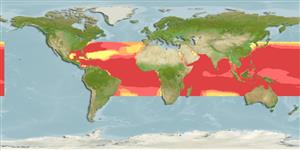Common names from other countries
Environment: milieu / climate zone / depth range / distribution range
Ecología
marino; oceanodromo (Ref. 51243); rango de profundidad 0 - 20 m. Subtropical; 40°N - 25°S
Indo-West Pacific: Red Sea and South Africa (including the Mascarenes, Ref. 33390) to southern Japan, Taiwan, Mariana, Caroline and Solomon islands, Queensland and the Arafura Sea (Ref. 9819). Western Atlantic: New Jersey, USA and northern Gulf of Mexico (Ref. 7251) to Rio de Janeiro, Brazil. Eastern Atlantic: Guinea to Gabon.
Tamaño / Peso / Age
Maturity: Lm ? range ? - ? cm
Max length : 40.0 cm TL macho / no sexado; (Ref. 5217); common length : 25.0 cm TL macho / no sexado; (Ref. 5217)
Espinas dorsales (total) : 0; Radios blandos dorsales (total) : 12 - 14; Espinas anales: 0; Radios blandos anales: 9 - 11. Body dark, iridescent blue dorsally, silvery white below; pectorals bluish black; dorsal fin with prominent black spot (Ref. 2797).
Inhabits both neritic and oceanic surface waters (Ref. 30573). Capable of leaping out of the water and gliding for long distances above the surface (Ref. 30573). Feeds mostly on crustaceans and other planktonic organisms; often attracted to lights at night (Ref. 2797).
Life cycle and mating behavior
Maturities | Reproducción | Spawnings | Egg(s) | Fecundities | Larva
Parin, N.V., 1996. On the species composition of flying fishes (Exocoetidae) in the West-Central part of tropical Pacific. J. Ichthyol. 36(5):357-364. (Ref. 27313)
IUCN Red List Status (Ref. 130435)
CITES (Ref. 128078)
Not Evaluated
Threat to humans
Harmless
Human uses
Pesquerías: escaso valor comercial
Herramientas
Special reports
Download XML
Fuentes de Internet
Estimates based on models
Preferred temperature (Ref.
115969): 21.7 - 29.1, mean 27.5 (based on 25528 cells).
Phylogenetic diversity index (Ref.
82804): PD
50 = 0.5000 [Uniqueness, from 0.5 = low to 2.0 = high].
Bayesian length-weight: a=0.00646 (0.00292 - 0.01429), b=3.04 (2.84 - 3.24), in cm Total Length, based on LWR estimates for this (Sub)family-body shape (Ref.
93245).
Nivel trófico (Ref.
69278): 3.3 ±0.38 se; based on food items.
Resiliencia (Ref.
120179): Alto, población duplicada en un tiempo mínimo inferior a 15 meses (K=0.8).
Fishing Vulnerability (Ref.
59153): Low vulnerability (21 of 100).
